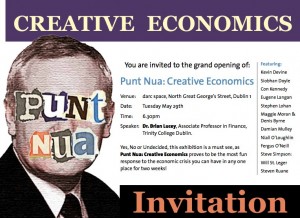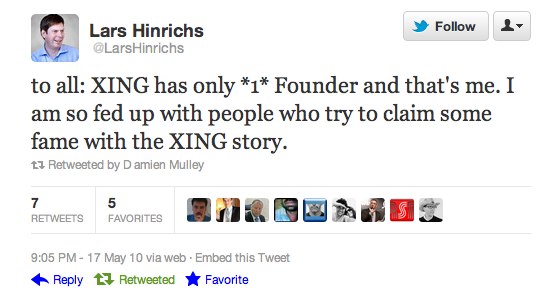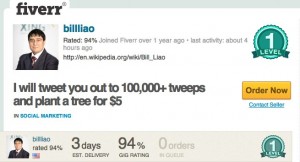Here are my 2012 Ones to Watch.
Play and read, if you want, this is from the film Holy Motors:
2012 was European Year of Older People telling younger people to cop themselves on, or something like that.
2013 is going to be the year of the younger person. Well, this list is certainly suggesting this. Oh yes, the new phrase is “younger person” as marketing people have redefined youth to be anyone 35 and younger. Technology has enabled ubiquitous communications, we’ve heard this for a decade now but in 2012 we really saw/heard the voice of younger people push the older (mostly male) grey haired “authorities” to the side. 2012 saw dealmaking in music for Soak, a wee teenager from Derry and a deal for The Strypes, the youngfellas from Cavan and they have a good few years before school ends. Another Irish “Stripe” is the Collison-fueled payments startup in San Francisco that already seems to be David to Paypal’s Goliath.
Technology has made geography easier, we can work from home when home can be a boat on a different continent. So many people not at home for Christmas checked into home with Skype and Facetime video calls. Technology allows time-shifting so we can watch TV and consume media whenever we want. While I watched The Late Late Toy Show live from a laptop in Cardigan, Wales, many in America just watched it on Saturday morning (their time) thanks to RTÉ player. Technology can break down class barriers and allow anyone to play with the big boys if they have talent.
Technology now is making age less of an issue, whether it’s older people logging on to Facebook encouraging their grandkids to give cheek to parents and playing good cop to their bad cop, or younger people taking part in events and building companies. Online has broken down the ringfences around demographics. Now 70 year olds can talk about crocheting with 18 year olds on the other side of the planet or turn up to tweet ups. I’m biased and bearish on this of course but the inter-democratic and inter-generational data that’s being exchanged enriches our society. 20 year olds are hanging with 50 year olds and they’re learning from each other. I love how Zuckerberg has absolute control of his public company thanks to older experienced people (and not yes-men) giving his advice. More of this.
Yet 2012 saw vulnerable people, many of them teens not have their voice heard or have someone let them know it’s ok to tell people if they’re feeling vulnerable. In this world of inter-connectedness and oversharing (personally think this is bullshit), people still meet barriers to check in with those that could be of help. There are still obstacles but things are getting better, the more we communicate. Anyway, shutting up and getting to the list:
Vincent Lyons and Ian Connolly
Them and Enda Crowley (who appeared before in this area) have been running Dubstarts in Dublin bringing tech people and tech companies together. Vincent is around 23 and Ian is 20 (awww). Networking events are crucial for any startup ecosystem to grow and flourish. Agenda fueled networking events won’t get the fun people, the creative people, the people who can make an impact. Dubstarts meets these criteria and helps companies hire in Dublin which for tech is a very aggressive hiring location.
Lyra Mckee
Lyra is 22 and properly causing a fuss in Northern Ireland with her tenacious, dogged, investigative journalism. When your supporters are pressured to shun you, you’re winning. Lyra is winning. What I like too is Lyra is blogging and tweeting as she goes, warts and all about her experiences. Won’t get that on a journalism course…
Conor Clinch
Conor has a lovely eye for detail. Thus why his photography skills are sought by many agencies and why he is now flying all over the shop to attend fashion shows. He built on his reputation in 2012 and I have a feeling that 2013 is going to be more of the same, except more. Impressive as it stands, even more so for the guy that’s only 17 a few days.
James Eggers
Sure didn’t James win a Web Award and before that a few Young Scientist Awards? James builds things and builds them well. BetterExaminations.ie is a lovely site that makes it much easier for students to find exam papers and the marking schemes for them. James likes to work with tech around big data, the current over-abused tech term by Government, like cloud before it but the actual applications for this are vastly important and it’s good to see people working on it. James and real-coders of his kind that can code at a professional level from a young age will impact on Ireland, whether the education system supports them or not. The Collisons below are such an example.
Marie Duffy
Now I’m biased as I’m on the board of Spunout and Marie was previously on the board and now works there. She’s a great communicator, has done wonders since she took over as Editor for Spunout and is creating a valued resource on all things young people related for Spunout. She was also in the States later in 2011 representing Irish people and hearing Bill Clinton and Kofi Annan talk away. Marie has always has strong interests in mental health issues for younger people and as Spunout comes out of their shell again after being in a cocoon for so long, her influence and work will make a great impact. Marie is 28.
The Collisons, all of them.
Again. Sure it’s not a list without them. All three this time. Patrick and John are about to flip the world of online payments upside down and deservedly featured on that Forbes under 30 list. What they do in Stripe is very real and is impacting on the world daily. Now we have Tommy (also mentioned before) finishing school and maybe heading to the States for college next year. Oh and at 18 has already self-published two books. They’re not over-achievers in my view, they’re just expanding out to use 100% of their talents.
Stephanie Francis
Actually Steph already announced she was leaving X Communications earlier in December. This post was in draft since November and she was on the list, I swear! Steph organises Crafthouse, worked in the talented X-Comms and did trojan work on the Book of Kells app. I expect her influence will be a very positive one for the Engine Yard team in 2013.
Token older person: Sean Blanchfield
He’s not old or really that older but compared to the quite young people on the list, he possibly could be classed as that. Seán has been supporting people and events including Dubstarts in the background for the past few years, being a very positive influence without seeking the attention and glory for it. There are lots of reasons why Dublin very much is a tech startup hub now and Seán is one.
Token older person and annual listee: Pat Phelan
See what I said for SB above. Pat is up to something, I can feel it in my bones. Plus he always makes this list and not adding him is bad luck. So what will Pat bring us in 2013?
Non-tech people:
Jack O’Keeffe and the other Young Chef’s. Coming to running a kitchen near you.







